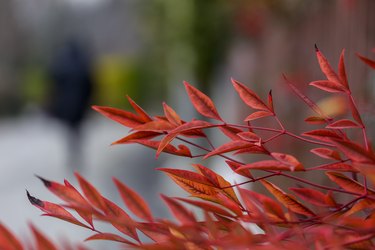
The Chinese pistache tree (Pistacia chinensis), aka Chinese pistachio, is an intriguing choice for landscaping in USDA plant hardiness zones 6-9. If you have enough space, it's a near-perfect landscape or shade tree. It's big and shapely (if you prune it properly when it's young), it grows at a reasonable pace once established, and it's much loved for its glorious show of fall color. It's also long-lived, so you won't need to replant after a couple of decades, and it's impervious to most pests and diseases. If you want a large tree to anchor your landscape, it's an outstanding candidate.
Chinese Pistache Tree Basics
Video of the Day
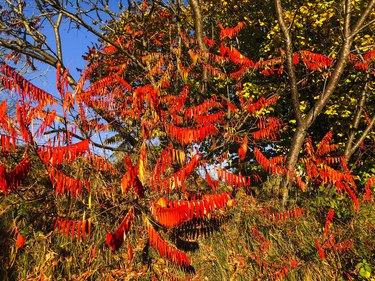
As you'd expect from its name, the tree does indeed originate in China and is a member of the pistachio family. Don't expect nuts, though; those come from a close relative called Pistacia vera.
Video of the Day
Like Pistacia vera, the Chinese pistache is dioecious, meaning that each individual tree is either male or female. Male trees produce pollen but not a pollen that will trouble most allergy sufferers. The blossoms of both male and female trees show as spikes (panicles) of red buds that give way to low-key greenish flowers and in female trees, ultimately small, inedible, berrylike red drupes. (In other words, a fruit with a stone in the middle; it's rather like a wild cherry.) Bloom time is in early spring before foliage emerges.
The Chinese pistache is large once fully grown, so it's not a tree you want to shoehorn into a tight corner. When fully grown, it will usually top out in the 25- to 35-foot range, though it can easily grow taller under good conditions. Its canopy typically spreads as wide as the tree is tall, so again, you'll need to allow space for it to cover a space up to 35 feet across.
Mature trees develop a smooth, rounded crown shape that spreads out from the trunk in a vaselike pattern. These trees are best grown with a single trunk (they look better and are more robust) and are highly resistant to breakage in wind.
Where to Plant a Chinese Pistache
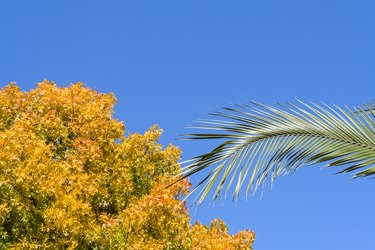
If you decide you want a Chinese pistache, choosing a spot that will physically accommodate its mature size is often the most difficult part of the process. It's not a finicky plant. In fact, Chinese pistache trees are often used as street trees because they're not picky about soil conditions, and they tolerate urban pollution well.
Though it will tolerate partial shade, this deciduous tree truly thrives and looks its best when planted in full sun. Loamy, well-draining soil is best, but the pistache tree will tolerate any soil type as long as its roots don't stay wet for extended periods. Soil pH also isn't a problem because the Chinese pistache will tolerate a pretty wide range and won't need fertilizing. One exception to its otherwise uncomplaining nature is salt; plantings should be avoided in areas where salt spray or salty soil is present, as its salt tolerance is very low.
The tree requires no fertilizer and is highly drought-tolerant once established, with a deep and durable root system (surface roots aren't a problem). It's only a moderate producer of litter in the form of dropped branches, blossoms and foliage. However, if you plant a female tree, the fruit will attract birds (and therefore bird droppings), and fruit will need to be cleaned up after falling. In short, it requires some maintenance but not nearly as much as many other trees.
How to Grow a Chinese Pistache
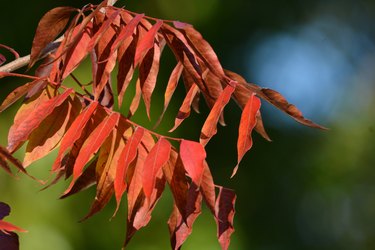
Chinese pistache trees have a medium growth rate of 13 to 24 in. per year, but you won't see that kind of growth initially. During the first five years, it will grow slowly and look rather gangly and gawky. You'll need to irrigate it regularly for the first two years until its root system is well established and prune the young tree during these early years to establish a strong central trunk and evenly spaced branch structure. After about the fifth year, your tree will begin to grow at a better pace. It will reach maturity in 12 to 15 years.
Visually, it's a striking tree and will bring year-round interest to your landscape. Its blossoms come first (in the spring), followed by graceful dark green foliage. Leaves turn vivid, beautiful shades of yellow, orange and red in the fall, with the most vivid colors appearing in the cooler parts of its range. The bright red fruits, when they appear, are also highly decorative if you have a female tree.
Even during the winter after leaves have fallen, the Chinese pistachio is a beautiful tree. The fruit lingers on branches after leaf-fall and look all the more striking on bare branches. The tree's broad branch structure and overall symmetry are pleasing to the eye, and even the bark rewards upon closer look. The outer bark is rough and craggy with a grayish-brown color, but it periodically splits and flakes to reveal salmon-colored inner bark beneath in pleasingly erratic patches.
Tip
The Keith Davey cultivar (Pistacia chinensis ‘Keith Davey’) is especially valued for its regular shape and vivid autumn foliage. It’s sold as a cloned male tree to keep litter to a minimum and reduce maintenance.
Chinese Pistache Facts
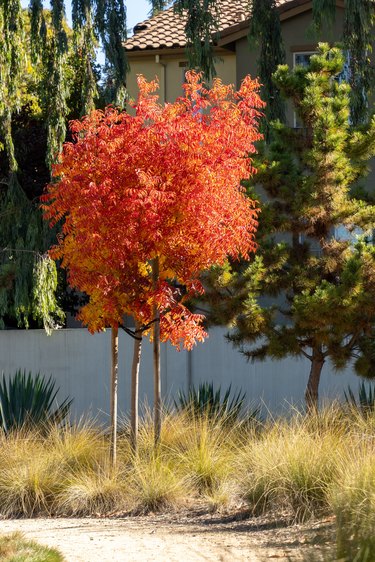
In no particular order, let's look at a few additional points about the Chinese pistache:
- Pests are not a problem for this hardy tree nor are most diseases. The Chinese pistache can sometimes fall victim to verticillium wilts and oak root fungus, but even these are rare, and if you know the symptoms, it's easy to catch them early and treat them.
- Non-native plants are often potentially invasive because they lack natural predators or competitors outside of their native range. That's not an issue with the Chinese pistache, in large part because of its relatively long "adolescence," so feel free to enjoy this tree anywhere in its ideal growing range.
- If your community is looking at street trees to provide shade and mitigate the effects of climate change, you might suggest the Chinese pistache. This tree is perfect for parking lot islands, yards, buffer strips, patios and anywhere a decorative shade tree is desired. It does well in polluted urban environments and is perfect for adding greenery into cityscapes.
- Birds and rodents feed on seeds of the Chinese pistache tree, so it will help support your local ecosystem, and its early blooming flowers support pollinators in the spring.
Because it's often gangly and misshapen when young, many gardeners and landscapers overlook the Chinese pistache tree. The tree grows into a beautiful garden focal point as it matures, however, leading many to refer to it as "the ugly duckling." But don't overlook this beautiful swan when planning your garden just because of its unsightly teen years.